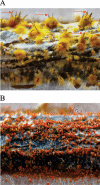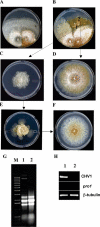Hypovirus-responsive transcription factor gene pro1 of the chestnut blight fungus Cryphonectria parasitica is required for female fertility, asexual spore development, and stable maintenance of hypovirus infection
- PMID: 19114501
- PMCID: PMC2653244
- DOI: 10.1128/EC.00338-08
Hypovirus-responsive transcription factor gene pro1 of the chestnut blight fungus Cryphonectria parasitica is required for female fertility, asexual spore development, and stable maintenance of hypovirus infection
Abstract
We report characterization of the gene encoding putative transcription factor PRO1, identified in transcriptional profiling studies as being downregulated in the chestnut blight fungus Cryphonectria parasitica in response to infection by virulence-attenuating hypoviruses. Sequence analysis confirmed that pro1 encodes a Zn(II)(2)Cys(6) binuclear cluster DNA binding protein with significant sequence similarity to the pro1 gene product that controls fruiting body development in Sordaria macrospora. Targeted disruption of the C. parasitica pro1 gene resulted in two phenotypic changes that also accompany hypovirus infection, a significant reduction in asexual sporulation that could be reversed by exposure to high light intensity, and loss of female fertility. The pro1 disruption mutant, however, retained full virulence. Although hypovirus CHV1-EP713 infection was established in the pro1 disruption mutant, infected colonies continually produced virus-free sectors, suggesting that PRO1 is required for stable maintenance of hypovirus infection. These results complement the recent characterization of the hypovirus-responsive homologue of the Saccharomyces cerevisiae Ste12 C(2)H(2) zinc finger transcription factor gene, cpst12, which was shown to be required for C. parasitica female fertility and virulence.
Figures







Similar articles
-
Ste12 transcription factor homologue CpST12 is down-regulated by hypovirus infection and required for virulence and female fertility of the chestnut blight fungus Cryphonectria parasitica.Eukaryot Cell. 2007 Feb;6(2):235-44. doi: 10.1128/EC.00302-06. Epub 2006 Nov 17. Eukaryot Cell. 2007. PMID: 17114597 Free PMC article.
-
Variation in tolerance and virulence in the chestnut blight fungus-hypovirus interaction.Appl Environ Microbiol. 2000 Nov;66(11):4863-9. doi: 10.1128/AEM.66.11.4863-4869.2000. Appl Environ Microbiol. 2000. PMID: 11055936 Free PMC article.
-
Comparative analysis of alterations in host phenotype and transcript accumulation following hypovirus and mycoreovirus infections of the chestnut blight fungus Cryphonectria parasitica.Eukaryot Cell. 2007 Aug;6(8):1286-98. doi: 10.1128/EC.00166-07. Epub 2007 Jun 8. Eukaryot Cell. 2007. PMID: 17557883 Free PMC article.
-
Biological control of chestnut blight with hypovirulence: a critical analysis.Annu Rev Phytopathol. 2004;42:311-38. doi: 10.1146/annurev.phyto.42.040803.140325. Annu Rev Phytopathol. 2004. PMID: 15283669 Review.
-
Cryphonectria parasitica, the causal agent of chestnut blight: invasion history, population biology and disease control.Mol Plant Pathol. 2018 Jan;19(1):7-20. doi: 10.1111/mpp.12542. Epub 2017 Apr 24. Mol Plant Pathol. 2018. PMID: 28142223 Free PMC article. Review.
Cited by
-
Genome-wide characterization of the Zn(II)2Cys6 zinc cluster-encoding gene family in Pleurotus ostreatus and expression analyses of this family during developmental stages and under heat stress.PeerJ. 2020 Jun 12;8:e9336. doi: 10.7717/peerj.9336. eCollection 2020. PeerJ. 2020. PMID: 32566411 Free PMC article.
-
Role of MAPK Signaling Pathways in Regulating the Hydrophobin Cryparin in the Chestnut Blight Fungus Cryphonectria parasitica.Mycobiology. 2017 Dec;45(4):362-369. doi: 10.5941/MYCO.2017.45.4.362. Epub 2017 Dec 31. Mycobiology. 2017. PMID: 29371804 Free PMC article.
-
It's All in the Genes: The Regulatory Pathways of Sexual Reproduction in Filamentous Ascomycetes.Genes (Basel). 2019 Apr 30;10(5):330. doi: 10.3390/genes10050330. Genes (Basel). 2019. PMID: 31052334 Free PMC article. Review.
-
The Role of Chromatin and Transcriptional Control in the Formation of Sexual Fruiting Bodies in Fungi.Microbiol Mol Biol Rev. 2022 Dec 21;86(4):e0010422. doi: 10.1128/mmbr.00104-22. Epub 2022 Nov 21. Microbiol Mol Biol Rev. 2022. PMID: 36409109 Free PMC article. Review.
-
Molecular characterization of vegetative incompatibility genes that restrict hypovirus transmission in the chestnut blight fungus Cryphonectria parasitica.Genetics. 2012 Jan;190(1):113-27. doi: 10.1534/genetics.111.133983. Epub 2011 Oct 20. Genetics. 2012. PMID: 22021387 Free PMC article.
References
-
- Anagnostakis, S. L. 1982. Biological control of chestnut blight. Science 215466-471. - PubMed
-
- Anagnostakis, S. L. 1984. Nuclear gene mutations in Endothia (Cryphonectria) parasitica that affect morphology and virulence. Phytopathology 74761-765.
Publication types
MeSH terms
Substances
Associated data
- Actions
- Actions
Grants and funding
LinkOut - more resources
Full Text Sources

